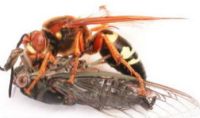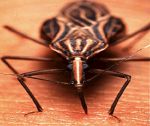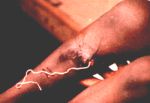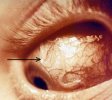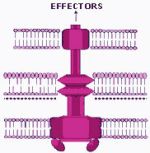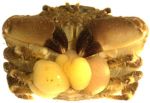 |
 |
|||||||||||
|
|
|||||||||||
|
Organisms that Look DesignedBy Allan Glenn[v.2.1; Major rewrite finished May 6, 2004] Posted November 6, 2005 The purpose of this pro-creationism essay is to document several potentially unevolveable organisms of staggering complexity and design. As much as evolutionists will try, their (often pathetic) attempts to deny the undeniable, that life exhibits all the hallmarks of intelligent design, inevitably falter when faced with the evidence. As the rest of this document demonstrates, intelligent creation is necessary to explain the mind-boggling complexity of many organisms.
The Argument from Irreducible Grotesqueness
In his 1996 best-seller God's S&M Chest, Dr. Behe describes, in meticulous detail, more than a dozen irreducibly grotesque organisms and their elaborately designed subsystems. He convincingly argues that multi-component maiming systems cannot evolve: Since evolution supposedly operates via incremental changes, the likelihood of spontaneously creating an IG system out of thin air, in one generation, drops exponentially as the number of required parts goes up. Since no other process, now known or hereafter discovered, can (even in principle) account for IG systems, intelligent design is verified by process of elimination. Heathen, God-hating evolutionists like Kenneth Miller have recognized how powerful this argument is at dispelling their propaganda, and have attempted several rebuttals. While the scope of this essay does not include addressing them, a few general observations, borrowed from Dr. Behe's latter writings, are in order. First, the common-sense fact that IG systems can't evolve is not refuted merely by demonstrating a possible evolutionary pathway. It's not enough merely to show that an IG system can evolve; the burden of proof rests squarely on the evos to show all of these did evolve. As Dr. Behe convincingly shows using a variety of scripture passages, the default assumption when dealing with biology should be design first, other processes second. Second, there's no evidence that evolution can cobble together IG systems. Evolutionists will mention examples of bacteria with new IG systems being found in isolated petri dishes. They'll point out the startling genetic similarities between bits of known systems used for other purposes, and a newly discovered IG system. They'll point to computer simulations ("genetic algorithms") which evolved multiple dozens of independent functions all required for a larger whole. They'll even show fossil series with anatomy that appears to incrementally change from an innocuous to grotesque function simply by modifying and refining existing components. But they can't really prove any of this. Bacterial colonies can be contaminated; similarities can be explained by similar design; computer simulations can be rigged; at least some fossils are likely planted by Satan; and finally, there's nothing preventing God from creating an IG system here or there through evolution. How does one design an experiment that, even in principle, excludes an omnipresent deity's possible influence? Until these "scientists" can answer that, their "vain babblings and oppositions of science falsely so called" (1 Tim 6:20) should be taken with a grain, or preferably bucket of salt. Third, the issue of plausible mechanisms cannot simply be ignored. This is where intelligent design truly shines. As any student of the Inquisition Era should know, intelligence can demonstrably create IG systems; but no other process capable of this has been documented (see point #2). Moreover, the life, miracle-working, and Resurrection of Jesus Christ is better attested historically than Augustus Caesar, World War II, and George W. Bush's incompetence put together. Our theory's mechanisms are simple, elegant and well supported, requiring no recourse to oddball hypotheses and idle speculation. Conversely, what evidence for their esoteric and unproven mechanisms of "natural selection" can evolutionists draw on? A few breeds of dog--which haven't evolved horns and learned to fly despite centuries of efforts to prove their theory--and some moths. Any reasonably open-minded person should see a credibility problem here. While Dr. Behe's book is a worthwhile (and exciting) read in and of itself, here is a more accessible, shortened summary of several particularly amazing organisms he describes. Complex Things, ergo Goddidit"All things sick and cancerous,
Cicada Killer Wasps (Sphecius speciosus). These critters have an utterly fascinating life cycle. After mating, the female digs a burrow. She excavates several oval chambers at the deep end. She then goes hunting for cicadas, stings them with a powerful paralyzing agent, and drags them back home. She lays eggs next to the cicadas and seals them up in the chamber. Incredibly, the venom only paralyzes, not kills; it preserves the cicadas, keeping them free from decomposition for several days while the larvae feast on their innards. The vital organs are eaten first, and the brain last. This IG organism requires an impressive mosaic of interdependent designs. Without the incapacitating preservative agent, the cicadas would begin decomposing well before the wasp's larvae hatch; without a sting to inject it with, the agent would be useless; without an instinct to dig the burrow, or drag the frozen cicada back home for that matter, the wasp would have gone extinct long ago; and so on.
Candiru catfish (Vandellia cirrhosa). This is a tiny catfish, often less than one inch long, that lives in the Amazon and Oranoco rivers of South America. Voraciously bloodthirsty, they often crawl up the anus or urethra of unsuspecting human bathers. They deploy specially built spines, located around their head, to draw blood and anchor themselves. Unfortunately, they then tend to swell and get stuck inside. The spines are designed so well that only surgery (usually amputation of the genital area) can get rid of them! The interplay of systems required for this little fish is similarly amazing. In particular, the spines are a miraculously crafted example of divine ingenuity.
Wuchereria bancrofti. The complex life cycle of this microscopic worm is simply a nail in the coffin for evolution! Bancroftian larvae, carried by tropical mosquitoes, infest the human bloodstream, where they migrate to the nearest lymph glands. Several months of development later, they emerge into the blood as adults. These parasites can survive in the blood for many years, causing severe damage to the lymphatic vessels. The subsequent immune response produces a disfiguring disease known as "elephantiasis." Eventually, the adult worms mate. Their offspring approach the lungs and are programmed to emerge at night, when mosquitoes are most active. When they get a chance, some of them enter a mosquito host, penetrate the gut wall, and slip into the insect's thoracic muscles. There, they mature into third-stage, human-infecting larvae to repeat this well-designed cycle all over again.
Kissing Bugs (Triatoma protracta and others). These insects, many of which can be readily identified by a distinctive "X" on their back, have such a fine biting mouthpart that the sleeping victim never even feels it piercing their lip, eyelids or ears to feed! Of course, as Dr. William Dembski has shown, there are "no free lunches"; the pain comes later, and some experience deadly anaphylactic shock from the insect's saliva. A finely-designed parasite which causes Chagas' disease, an incurable form of African sleeping sickness, is also sometimes transmitted by the bug. If you live in a Central or Southern American country, where some estimates place 25% of the population at risk, you may want to pray that God protects you from His creations.
Lions (Panthera leo). As zoologists have long observed, these rank among the most efficient terrestrial killing machines on the planet. The lion's combination of speed, stealth, brute strength and state-of-the-art weaponry is beyond repute. A lesser-known lion fact is that adult males, when they take over a rival pride's territory, seek out and tear apart every one of the loser's cubs. As a result, their mothers come into heat sooner, which lends certain benefits to the males. As before, this instinct is difficult to explain without invoking a design hypothesis. The lions need to track down cubs, positively identify them as someone else's, and only then kill them. How would such an elaborate series of complex instincts...just evolve?
Tunga penetrans. These ectoparasitic insects are known by many names--"chiggers" and similar dialectical variants, sand fleas, and so on. Unlike other fleas, they can burrow into and survive under the skin of the host. This can cause devastating skin damage--and creates an opportunity for secondary infections by bacteria--especially around the paws and scrotal area. Favored hosts include domesticated animals like dogs and goats, but the fleas can infest a wide variety of animals; as a result, people are often cross-infected. Once they set up shop, getting them out from under the skin can be a difficult affair, usually requiring painstaking surgical removal of individual fleas. This testifies to their effectiveness as an obviously designed biological weapon.
Screw-worm flies (Chrysomia bezziana, Cochliomyia hominivorax). These flies are attracted to damaged or soiled skin/fur, and lay their eggs right in exposed areas such as eyes and mucous membranes. When the maggots emerge, they burrow into the animal's flesh and feed there, resulting in "fly strike." This is reportedly one of the most sickening conditions ever treated by veterinarians, and can cause a debilitating, painful death if left untreated. Like several examples above, the screw-worm fly has splendidly designed life cycle involving a number of systems, all working in unison, to make it possible at the expense of a host. Eat that, evolution!
Tongue-eating isopod (Cymothoa exigua). This small crustacean feeds on the tongue of the rose snapper, its host fish. The snapper's tongue eventually atrophies and degenerates from this activity. The isopod then uses advanced hook-like structures to attach itself to the fish's mouth, remaining there and acting as a replacement tongue (while getting first shots at any incoming meals). This bizarre creature from the depths of the Gulf of California points out God's...interesting sense of humor. But it's also a nasty problem for evolution. The isopod's anchoring mechanism, instincts, and ability to skillfully avoid being eaten as it feasts on the fish's tongue (and later, steals food) requires an intelligent designer to explain.
Mycobacterium leprae. This bacterium, which causes leprosy, has several complex systems designed to defeat the protection offered by the (also designed) immune system. This includes lipid disguises, the ability to hijack a discarded immune system protein to mask itself from white blood cells, suppressing the immune response itself, and other mechanisms. Aided by these God-given abilities, the germ invades the body and causes permanently disfiguring lesions, sensory loss in the affected areas, and other symptoms. In the latter stages, gangrene can set in, resulting in the death of entire body parts.
Borrelia burgdorferi [free registration at The Scientist required to read]. This spirochete, which causes 10,000 or so cases of Lyme disease in the United States per year, continues to confound scientists with its legendary immune system-bypassing mechanisms. Even evolutionists admit the startling analogies to human-designed IG systems it exhibits. In early stages of infection, it escapes detection in the bloodstream by decreasing emissions of surface proteins; it can also cloak itself under a special layer of slime. "It's using some sort of stealth-bomber-type mechanism," notes Yale veterinary researcher Stephen Barthold. It can also pinch off bits of its membrane to divert immune system resources on a wild goose chase, a process known as "blebbing." Dr. Alan G. Barbour of the University of Texas Health Science Center (San Antonio), author of Lyme Disease: The Cause, the Cure, the Controversy (Johns Hopkins University Press, 1996) concedes that "It's like a bacterial Star Wars defense program," an impressive admission from an evolutionist. Unfortunately, despite their ability to see the obvious hallmarks of design in this little bacterium, scientists simply can't admit that their cherished naturalistic theories on the origin of the universe and life are wrong.
Tapeworms (subclass Cestoda). This diverse variety of parasitic organisms is a veritable marvel of engineering. The adult worm's head contains a staggering assortment of barbed hooks and suckers lining the edges, which enable it to hold on to the intestine. In the meantime, the host faces vitamin B-12 deficiency and malnutrition; brain, liver, heart and lung problems caused by infestation of those organs; potentially fatal anaphylaxis (allergic reaction) from ruptured worm cysts; and a variety of other problems. But I digress.... The lifecycle of these creatures makes evolutionary biologists run home crying to their mommas. Inside the intestine, they produce hundreds of reproductive segments, each of which contains thousands of larvae. These segments pass thru the feces of the primary host, are left on grass, and get ingested by smaller, intermediate hosts like rats. Once eaten by the secondary host, the larvae burrow through its intestinal wall and lodge inside muscle tissue or internal organs. When a predator eats the insides of an infested animal, the larvae emerge, travel to the animal's intestines, and begin to repeat the cycle. Surely, this is a lifecycle that just screams of the super-intelligent mind Who designed it!
Bee orchids (genus Ophrys). While not an irreducibly grotesque system, this unusual group of flowers should still be noted as a problem for evolution. Their structure mimics that of female bees and wasps, down to copying their looks and even pheromones. When a lonely male insect tries to mate with one, a specialized organ (appropriately called the "labellum") coats him with pollen. This ensures that other flowers of the same species will be pollinated later, and demonstrates that you can catch more bees with sex than you can with honey... Dr. Behe (begrudgingly) puts forth a rock-solid scriptural case that the God of the Bible could not have created these flowers. While the other organisms listed here have dramatic precedent in the plagues, devastations, etc. of both Old and New Testaments, a flower specifically designed to promote kinky, cross-species sex is out of the question. He hypothesizes that this is the result of Satan's diabolically perverted influence on the origin of species. Dracula ants (Adetomyrma venatrix). Adults of this species of Madagascar ant have some rather unusual feeding habits. When hungry, they sometimes tear holes in the head of their own larvae and drink the blood, a.k.a. hemolymph, that flows within.
Killer Whales (Orcinus Orca). The cute, cuddly marine mammals we all recognize from Sea World and a variety of TV documentaries. But beneath their attractrive exterior lies a harsher, ruthless side. They may appear harmless, but in truth they're some of the most powerful and ruthless predators ever to grace the sea. Their voracious appetite for seals, sea lions, dolphins and even other whales knows few bounds.
Orcas take their time with meals, like the best of connoisseurs. As noted in the 2002 report on Predation Behavior of Transient Killer Whales in Monterey Bay, California, their hunting will involve a "...long process of incapacitating... by tossing, body and tail slams, and then in most cases, ending the attack by drowning the prey." Orcas will drown a creature by dragging it under the water for as long as necessary. For many marine mammals that can hold their breath well, such as the Northern Elephant Seal, this ordeal can last for over an hour. Most impressive is the way Killer Whales deal with their brethren, the Gray Whales:
The Killer Whale--one of the most powerful killing machines on the planet, a veritable submarine nightmare--the product of chance, or meticulous Design?
Rabies (genus Lyssavirus). Upon infection, this incredible RNA-based virus modifies the host animal's behavior and physiology in several subtle ways that help it spread further. It causes the following symptoms:
To suggest that evolution, an utterly mindless process lacking a specified goal, could program the rabies virus to successfully hijack its host's neurology and physiology to its own benefit with such damning attention to detail stretches credulity to the breaking limit.
Guinea worms (Dracunculus medinensis). Another creature with an interesting multi-stage lifecycle, the adult of this species actually requires a human host. Described by Greek, Roman, Arabian and other scholars in antiquity, possibly the "fiery serpents" alluded to by Numbers ch. 21, the disease has a long and fascinating history among tribes living in arid lands. The female of the species can grow several feet in length, and is quite a sight to behold. They grow up under the skin, most commonly in the legs, ankles and feet. Interestingly, once they mate, the adult males die off; only the females remain. Their bodies become disturbingly swollen with a huge number of embryos. Eventually, the female worm's body wall bursts open, causing a massive allergic reaction and extreme irritation; this is possibly responsible for the origin of the term "fiery serpent." A painful ulcer then develops, which eventually ruptures as well. The worm then comes out, partially extending itself from the opening, and begins to expel its offspring. Removing the worm, which can be a meter long, is an all-or-nothing deal. Anaphylactic shock will set in if only part of the body is severed. The most common folk remedy, albeit one that neither guards against the side effects of infestation nor prevents reinfection, is slowly and very carefully winding the exposed worm onto a short stick over the course of several days, removing it from the wound bit by bit. Afflicted individuals usually seek out water sources to dull the pain and clean the wound. This plays right into the worm's lifecycle: The embryos seek out water as they emerge and are quickly eaten by copepods, tiny shrimp-like crustaceans, which serve as the intermediate host. New human victims are then infected as they drink water contaminated with infected copepods, and the spectacular cycle begins anew.
Babirusa hog (Babyrousa babyrussa). This odd-looking Indonesian pig, while not dangerous to humans, is another excellent example of God's sense of humor. The males have brittle tusks that develop from their canine teeth and curve back inwards on their heads; they continue growing throughout and, if not broken off in the course of life, eventually pierce their skull between the eyes. The bizarre appearance of this creature (endemic to Sulawesi Island) has spawned many legends and superstitions among the populace, such as inspiring the creation of shamanistic masks.
Eye worms (Loa loa). Don't let the name fool you. Adults of this African nematode species, which can measure around a centimeter in length, can nest under the skin in virtually any part of the body. Along the way, they can cause intense inflammation. Several infestations in the same tendon can cause permanent, extremely painful, incapacitating cyst-like swellings. Once inside the body, developing worms become fairly restless and travel throughout the skin. Their name is inspired by the most common form of the parasite's detection--the horrified host (or their friends) noticing the worms as they swim around on (and often damage) the eyeball. Like many other parasitic worms, Loa loa larvae exploit an intermediate vector species on their way to and from humans. In this case, the honors are bestowed on infested Chrysops flies. As you can see, this is another undeniably IG system involving several interacting components--the worm, an intermediate host, and our target species itself. And that's even ignoring peripheral considerations, such as structures the flies and worms possess that work to make such diabolical infiltration possible in the first place: wings, biting mouthparts, complex muscle groups, instincts, etc.
Flesh-eating bacteria (Streptococcus pyogenes). Particularly virulent strains of A group streptococci feed on human flesh, causing the dreaded Necrotizing Fasciitis/Myositis, which you've no doubt sporadically heard about in the news. While a comparatively rare disease, the symptoms are quite grotesque, and are more than enough to warrant the attention it's received over the past several years. But this bacterium isn't just a one-trick pony; it possesses a variety of meticulously designed virulence factors, and is an overall marvel of infectious creativity. It can also cause:
As you can see, you never know just what you're going to get! Think of it as God's personal version of Wheel of Fortune.
Sand Tiger sharks (Odontaspis taurus & related sp.). Although not (generally) a threat to swimmers, this vicious-looking shark has another curious aspect worth noting--its reproductive system. Unlike most sharks, which lay eggs, female Sand Tigers give birth to no more than two live pups. However, they originally have several more embryos than that. Inside the uterus, which is separated into two sections, the first pup to hatch in each chamber simply devours the rest. Reproduction in general involves several interdependent systems; but this particular example is even more impressive. This shark's very womb shows the marks of a great intelligence--an intelligence that likes to play practical jokes on its creations. In other words, Someone like the God of the Bible. Is this yet another coincidence that makes sense under creationism, but none with evolution?
The Bubonic Plague bacterium (Yersinia pestis). The reasons this ancient menace is so dangerous are not yet entirely understood, but a large part of it surely involves the Type III virulence factor injection system the germ possesses. This system is too complex to describe without technical language, so let's quote from the description at the University of Georgia's website (above):
"Once inside the host, Y. pestis build the Ysc injectisome... a structure comprised of 27 proteins which function as a syringe-like organelle spanning the cell membrane... [which] achieves contact with the host cell via adhesions and integrins on Y. pestis. Yop B and Yop D are transported through the injectisome by ATP hydrolysis into the host cell membrane. Once inserted into the cell membrane, effector Yops disrupt the actin cytoskeleton of the host cell membrane. This system gives Y. pestis the ability to evade phagocytosis, preventing an inflammatory response which leads to massive tissue colonization." Dr. Behe quotes the type III organelle as the single best, flagship example of an irreducibly grotesque system currently known. It has not a few, but dozens of interdependent components; it serves a single, specific function, lending the germ which carries it the ability to penetrate cell membranes and inject them with potent toxins; and it eerily resembles syringes and darts used by assassins and international terrorists around the world. If evolutionists cannot concede this fascinating bit of cellular machinery is designed by a profound intelligence, then nothing will convince them, and they truly are "without excuse" (Romans 1:19-20).
Sacculina
Carcini. This barnacle, possibly the crowning glory of earth's
biota, can castrate and quite literally zombify the Green River crab. The
female floats in the water, finds a crab, drills a hole in its leg, and
injects a small amount of her innards. These cells wander around inside
the crustacean and eventually lodge in its belly. Possession tendrils
begin to infest the entire creature, forcing it to stop growing. If male,
the crab is feminized; the parasitic barnacle's egg sac replaces the
original reproductive system. As the above examples, along with thousands more, illustrate, evolutionists simply can't explain the incredible complexity found in nature in terms of any unintelligent process. What good is half a Candiru head, or a few bits of a type III secretion system? How could Guinea Worms survive in an intermediate form without a human host? Some (of the more liberal) Christians claim these organisms were benign in the past and "degenerated" after the Fall. But this is an ill thought-out position. Parasites aren't just slimmed-down versions of analogous creatures. While they can lack redundant (vis a vis their lifestyle) features like an independent digestive tract or ability to survive outside the bloodstream, as shown above, they have other, equally complex features--like a variety of startling abilities to infiltrate, evade immune detection and modify host behavior--to make up for it. Attributing such effective engineering solutions to a degenerative evolutionary process, as opposed to God's creativity, not only may qualify as heresy, but is contradicted by the evidence. Only one conclusion can really explain the data--these organisms, and the specific features they possess, are individually, unmistakably, intelligently and painstakingly designed for various...specific purposes. Coincidentally, the reason some continue to insist on blind processes such as mutation and natural selection in the face of overwhelming evidence to the contrary is because the alternative--creation--is an uncomfortable infringement on their sinful lifestyle. If the God described in the Bible, who designed the organisms listed above, exists, drowning children (Gen. 7:21-22), waging ideological wars of attrition (Deut. 20:16-17), stoning disobedient sons (Deut. 21:18-21), owning slaves (Lev. 25:44-46), keeping virginal war prisoners and massacring the rest (Num. 31:17-18), executing rape victims if they don't cry out (Deut. 22:23-24), hating your family (Lk 14:26), etc. are obligatory if He so desires. It's obvious why evolutionists would reject the concept of God and objective Biblical morality for their quaint, humanistic notions of "equality," "justice" and so forth. Belief that we came from a molecular soup (or "magic clay", like that really silly Cairns-Smith hypothesis claims) naturally leads to such insubordination. But the woeful immorality of evolutionists isn't the subject
of this essay; whether they can account for the magnificent, highly
refined systems found in nature is. They can deny their maker all they
want, but their "scientific" hand-waving rings hollow, for the evidence
screams for itself, so to speak. Which is more reasonable to believe? That
all these incredibly complex, purposeful designs, painstakingly crafted
for the brilliantly-executed infliction of pain and death, are the result
of a blind, totally indifferent natural process, or the culmination of the
master plans of the most devious (and inspired) engineer ever to
exist?
© 2002-2004 WinAce. You may freely print and reproduce this document for non-commercial purposes. |

